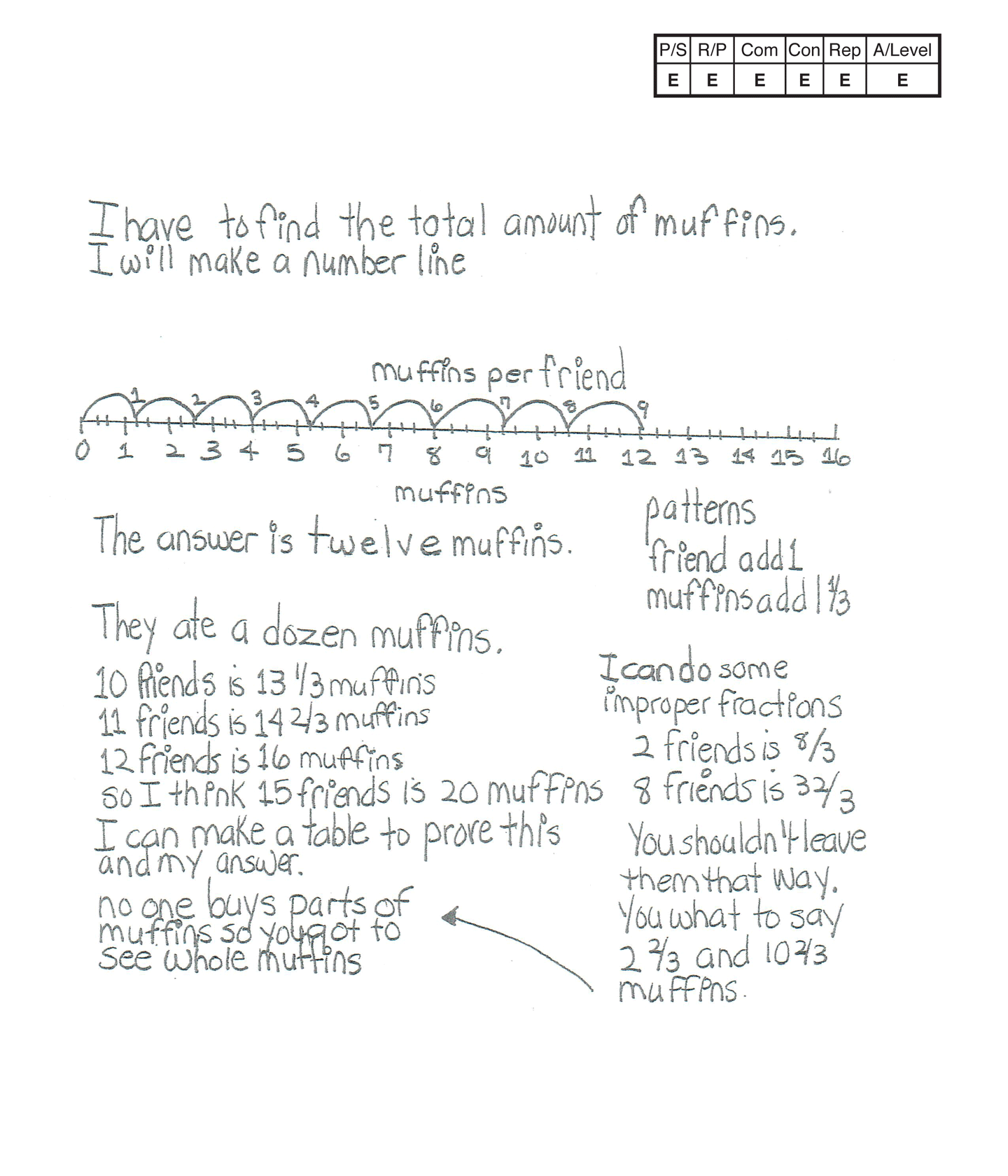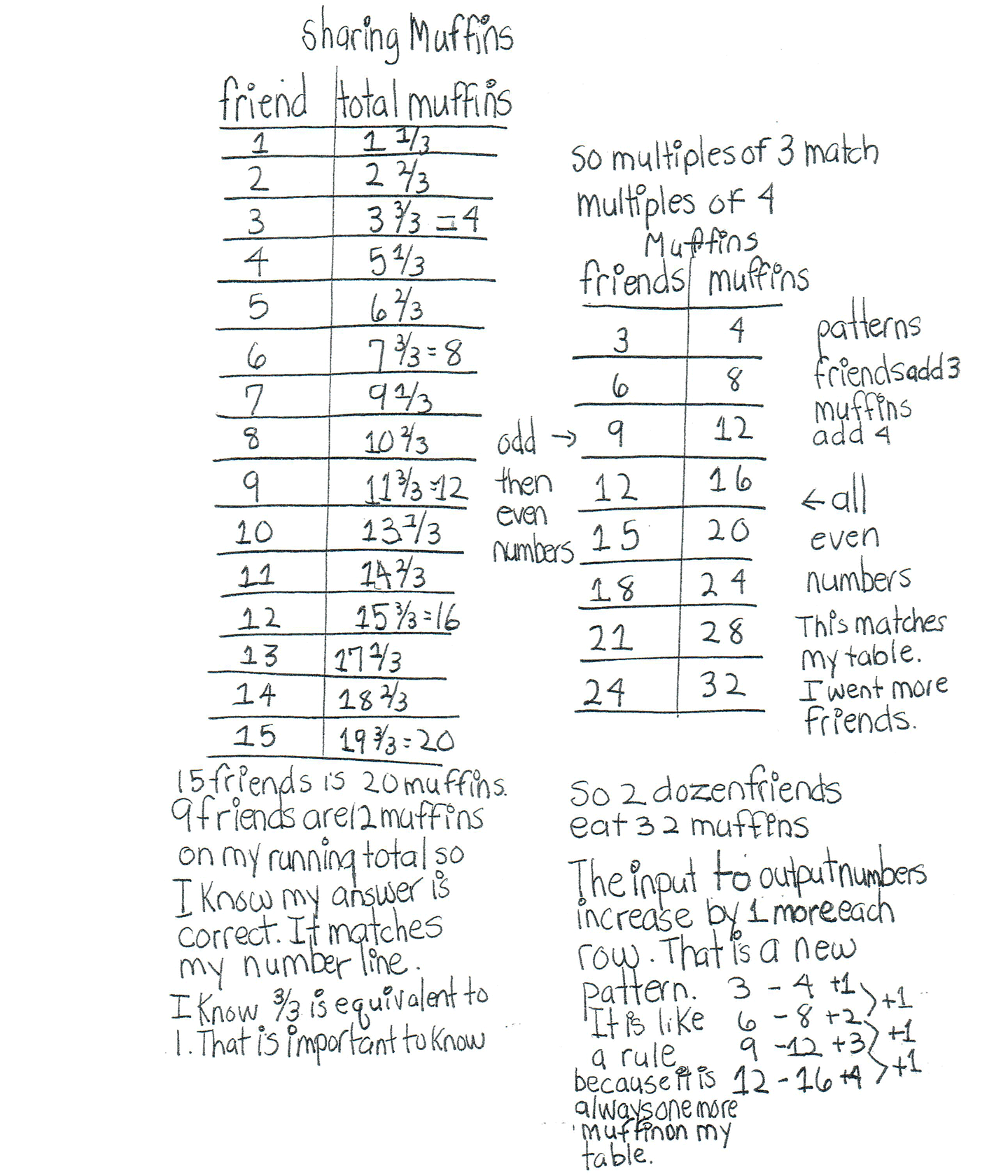Sharing Muffins
Problem Solving
expert
Problem Solving Rationale
<p>The student's strategy of using a number line to show the number of muffins per friend and the total number of muffins works to solve the task. The student's answer, "The answer is twelve muffins," is correct. The student uses an alternative strategy of a table to verify their answer, and brings the knowledge of percents to the task. </p>
Reasoning and Proof
expert
Reasoning Proof Rationale
<p>The student demonstrates correct understanding of the underlying mathematical concepts of whole, fractional parts of a whole, and addition of fractions to find a total amount of muffins. The student verifies that their answer is correct by using a table. The student makes a generalization about the multiples of three and four determining whole numbers of muffins and shows understanding of 33 1/3%.</p>
Communication Level
expert
Communication Rationale
<p>The student correctly uses the mathematical terms <i>total, amount, number line, per, patterns, dozen, table, whole, multiples, odd, even numbers, running total, equivalent, dozen, input, output, row, rule, more, percents, diagrams</i>. The student correctly uses the mathematical notation 1 1/3, 13 1/3, 14 2/3, 8/3, 32/3, 2 2/3, 3 3/3, 5 1/3, 6 2/3, 7 3/3, 9 1/3, 10 2/3, 11 3/3, 15 3/3, 17 1/3, 18 2/3, 19 3/3, 3/3, 100%, 33 1/3%, 1 1/2, 13 1/2. </p>
Connections Level
expert
Connections RationaleSharing Muffins
<p>The student makes the mathematically relevant Practitioner observations, "Patterns friend add 1, muffins add 1 1/3," "They ate a dozen muffins," "I can do some improper fractions. 2 friends is 8/3, 8 friends is 32/3," "You shouldn't leave them that way. You want to say 2 2/3 and 10 2/3 muffins. no one buys parts of muffins so you got to see whole muffins," "odd then even numbers," "patterns friends add 3, muffins add 4," "all even numbers," "I know 3/3 is equivalent to 1. That is important to know," "So 2 dozen friends eat 32 muffins," and, "If each friend eats 1 1/2 muffin you need 13 1/2 muffins so you have to buy 14 muffins." The student makes Expert connections. The student lists the number of muffins for 10, 11, and 12 friends and predicts, "so I think 15 friends is 20 muffins." The student verifies their thinking. "I can make a table to prove this and my answer." The student makes a table of 15 friends and muffins and states, "15 friends is 20 muffins. 9 friends are 12 muffins on my running total so I know my answer is correct. It matches my number line." The student makes another table to support their thinking that "the multiples of 3 match multiples of 4." The student states, "This matches my table. I went more friends." The student makes a generalization about their table of multiples. "The input to output numbers increase by 1 more each row That is a new pattern. It is like a rule because it is always one more muffin on my table. 3 - 4 + 1, 6 - 8 + 2, 9 - 12 + 3, 12 - 16 + 4" (with the + 1 pattern also indicated). The student also uses a diagram to compare a whole muffin to 100% and 1/3 of a muffin to 33 1/3%.</p>
Representation
expert
Representation Rationale
<p>The student's number line is appropriate to the problem and accurate. All necessary labels are indicated and the spacing between fractional parts is correct. The student's two tables are appropriate and accurate. All titles and column labels are correct and all entered data is correct. The student's diagram is appropriate and accurate. The muffins and fractional parts of one muffin are labeled correctly. The student uses their representations to verify the answer and support generalizations formed from patterns found in their tables.</p>



